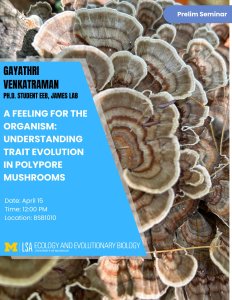Presented By: Ecology and Evolutionary Biology
EEB Prelim Seminar Series - A Feeling for the Organism: Understanding Trait Evolution in Polypore Mushrooms
Gayathri Venkatraman Ph.D. Student EEB, James Lab

Talk Title: A Feeling for the Organism: Understanding Trait Evolution in Polypore Mushrooms
Summary: My project proposal broadly investigates macrofungal evolution through a specific focus on sporocarp traits. For this, I use two different species of wood-inhabiting fungi that produce fruiting bodies having a poroid hymenophore (porous spore producing layer on the underside of the mushroom), commonly referred to as polypores. Polypores, which form a polyphyletic group within Basidiomycota, are unique in harboring species that produce annual and perennial hardy, poroid fruiting bodies which can remain exposed to the external environment and maintain functionality for long periods of time. Unlike the fruiting bodies of a majority of macrofungal species, given the persistence of certain polypore fruiting bodies on their wood-substrate over extended time periods, species within Polyporaceae are suitable for investigating the evolution of life history traits and adaptation in macrofungi. My PhD project will focus on two established traits- colour polymorphism and longevity; and will further use population genetics to identify traits that may be important for local adaptation. The first two chapters will be focussing on Trametes versicolor (aka Turkey Tail) which is a highly colour polymorphic, globally distributed, hardwood decay fungus found growing on a wide range of hardwood species. Using T. versicolor, I firstly aim to uncover if colour polymorphism in the species is linked to the wood species it grows on or if it is a heritable trait; and secondly, aim to determine whether it has population structuring across its geographic distribution, and local adaptation to each habitat of occurrence. In my third chapter, I propose to use Ganoderma applanatum (aka Artist’s conk) which has a perennial fruiting body that remains functional and fertile for several years to investigate senescence and the evolution of this alternate life history strategy.
Summary: My project proposal broadly investigates macrofungal evolution through a specific focus on sporocarp traits. For this, I use two different species of wood-inhabiting fungi that produce fruiting bodies having a poroid hymenophore (porous spore producing layer on the underside of the mushroom), commonly referred to as polypores. Polypores, which form a polyphyletic group within Basidiomycota, are unique in harboring species that produce annual and perennial hardy, poroid fruiting bodies which can remain exposed to the external environment and maintain functionality for long periods of time. Unlike the fruiting bodies of a majority of macrofungal species, given the persistence of certain polypore fruiting bodies on their wood-substrate over extended time periods, species within Polyporaceae are suitable for investigating the evolution of life history traits and adaptation in macrofungi. My PhD project will focus on two established traits- colour polymorphism and longevity; and will further use population genetics to identify traits that may be important for local adaptation. The first two chapters will be focussing on Trametes versicolor (aka Turkey Tail) which is a highly colour polymorphic, globally distributed, hardwood decay fungus found growing on a wide range of hardwood species. Using T. versicolor, I firstly aim to uncover if colour polymorphism in the species is linked to the wood species it grows on or if it is a heritable trait; and secondly, aim to determine whether it has population structuring across its geographic distribution, and local adaptation to each habitat of occurrence. In my third chapter, I propose to use Ganoderma applanatum (aka Artist’s conk) which has a perennial fruiting body that remains functional and fertile for several years to investigate senescence and the evolution of this alternate life history strategy.